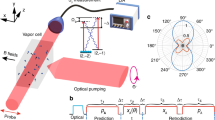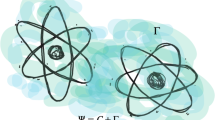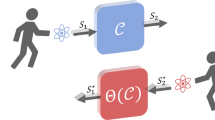Abstract
Does quantum theory apply at all scales, including that of observers? New light on this fundamental question has recently been shed through a resurgence of interest in the long-standing Wigner’s friend paradox. This is a thought experiment addressing the quantum measurement problem—the difficulty of reconciling the (unitary, deterministic) evolution of isolated systems and the (non-unitary, probabilistic) state update after a measurement. Here, by building on a scenario with two separated but entangled friends introduced by Brukner, we prove that if quantum evolution is controllable on the scale of an observer, then one of ‘No-Superdeterminism’, ‘Locality’ or ‘Absoluteness of Observed Events’—that every observed event exists absolutely, not relatively—must be false. We show that although the violation of Bell-type inequalities in such scenarios is not in general sufficient to demonstrate the contradiction between those three assumptions, new inequalities can be derived, in a theory-independent manner, that are violated by quantum correlations. This is demonstrated in a proof-of-principle experiment where a photon’s path is deemed an observer. We discuss how this new theorem places strictly stronger constraints on physical reality than Bell’s theorem.
This is a preview of subscription content, access via your institution
Access options
Access Nature and 54 other Nature Portfolio journals
Get Nature+, our best-value online-access subscription
$29.99 / 30 days
cancel any time
Subscribe to this journal
Receive 12 print issues and online access
$209.00 per year
only $17.42 per issue
Buy this article
- Purchase on Springer Link
- Instant access to full article PDF
Prices may be subject to local taxes which are calculated during checkout





Similar content being viewed by others
Data availability
Data that support the plots within this paper and other findings of this study are available from the corresponding authors upon reasonable request. Source data are provided with this paper.
Code availability
The numerical codes used to determine the inequalities and to choose the measurement settings are available from the corresponding authors upon reasonable request.
References
Wigner, E. P. in The Scientist Speculates (ed. Good, I. J.) 284–302 (Heinemann, 1961).
Schlosshauer, M. Decoherence, the measurement problem, and interpretations of quantum mechanics. Rev. Mod. Phys. 76, 1267–1305 (2005).
Leggett, A. J. The quantum measurement problem. Science 307, 871–872 (2005).
Everett, H. ‘Relative state’ formulation of quantum mechanics. Rev. Mod. Phys. 29, 454–462 (1957).
Rovelli, C. Relational quantum mechanics. Int. J. Theor. Phys. 35, 1637–1678 (1996).
Fuchs, C. A. & Schack, R. Quantum-Bayesian coherence. Rev. Mod. Phys. 85, 1693–1715 (2013).
Mermin, N. D. Physics: QBism puts the scientist back into science. Nature 507, 421–423 (2014).
Bohm, D. A suggested interpretation of the quantum theory in terms of ‘hidden’ variables. I. Phys. Rev. 85, 166–179 (1952).
Bohm, D. A suggested interpretation of the quantum theory in terms of ‘hidden’ variables. II. Phys. Rev. 85, 180–193 (1952).
Price, H. Toy models for retrocausality. Stud. Hist. Philos. Sci. B Mod. Phys. 39, 752–761 (2008).
’t Hooft, G. The free-will postulate in quantum mechanics. Preprint at https://arxiv.org/abs/quant-ph/0701097 (2007).
Bassi, A. & Ghirardi, G. Dynamical reduction models. Phys. Rep. 379, 257–426 (2003).
Penrose, R. On gravity’s role in quantum state reduction. Gen. Relat. Gravit. 28, 581–600 (1996).
Brukner, Č. A no-go theorem for observer-independent facts. Entropy 20, 350 (2018).
Brukner, Č. in Quantum [Un]Speakables II: Half a Century of Bell’s Theorem (eds Bertlmann, R. & Zeilinger, A.) 95–117 (Springer, 2017).
Frauchiger, D. & Renner, R. Quantum theory cannot consistently describe the use of itself. Nat. Commun. 9, 3711 (2018).
Proietti, M. et al. Experimental test of local observer independence. Sci. Adv. 5, eaaw9832 (2019).
Baumann, V. & Wolf, S. On formalisms and interpretations. Quantum 2, 99 (2018).
Healey, R. Quantum theory and the limits of objectivity. Found. Phys. 48, 1568–1589 (2018).
Baumann, V., Del Santo, F. & Brukner, Č. Comment on Healey’s ‘Quantum theory and the limits of objectivity’. Found. Phys. 49, 741–749 (2019).
Shimony, A. in Foundations of Quantum Mechanics in the Light of New Technology (ed. Kamefuchi, S.) 225–230 (Physical Society of Japan, 1984).
Kochen, S. & Specker, E. P. The problem of hidden variables in quantum mechanics. J. Math. Mech. 17, 59–87 (1967).
Liang, Y.-C., Spekkens, R. W. & Wiseman, H. M. Specker’s parable of the overprotective seer: a road to contextuality, nonlocality and complementarity. Phys. Rep. 506, 1–39 (2011).
Wiseman, H. M. & Cavalcanti, E. G. in Quantum [Un]Speakables II: Half a Century of Bell’s Theorem (eds Bertlmann, R. & Zeilinger, A.) 119–142 (Springer, 2017).
Cavalcanti, E. G. Classical causal models for Bell and Kochen–Specker inequality violations require fine-tuning. Phys. Rev. X 8, 021018 (2018).
Healey, R. Reply to a comment on ‘Quantum theory and the limits of objectivity’. Found. Phys. 49, 816–819 (2019).
Peres, A. Unperformed experiments have no results. Am. J. Phys. 46, 745–747 (1978).
Bell, J. S. On the Einstein Podolsky Rosen paradox. Physics 1, 195–200 (1964).
Brunner, N., Cavalcanti, D., Pironio, S., Scarani, V. & Wehner, S. Bell nonlocality. Rev. Mod. Phys. 86, 419–478 (2014).
Giustina, M. et al. Significant-loophole-free test of Bell’s theorem with entangled photons. Phys. Rev. Lett. 115, 250401 (2015).
Hensen, B. et al. Loophole-free Bell inequality violation using electron spins separated by 1.3 kilometres. Nature 526, 682–686 (2015).
Shalm, L. K. et al. Strong loophole-free test of local realism. Phys. Rev. Lett. 115, 250402 (2015).
Woodhead, E. Imperfections and Self Testing in Prepare-and-Measure Quantum Key Distribution. PhD thesis, Univ. libre de Bruxelles (2014).
Colbeck, R. Quantum and Relativistic Protocols for Secure Multi-Party Computation. PhD thesis, Univ. of Cambridge (2006).
Pironio, S. et al. Random numbers certified by Bell’s theorem. Nature 464, 1021–1024 (2010).
Acín, A. & Masanes, L. Certified randomness in quantum physics. Nature 540, 213–219 (2016).
Collins, D. & Gisin, N. A relevant two qubit Bell inequality inequivalent to the CHSH inequality. J. Phys. A 37, 1775–1787 (2004).
Clauser, J. F., Horne, M. A., Shimony, A. & Holt, R. A. Proposed experiment to test local hidden-variable theories. Phys. Rev. Lett. 23, 880–884 (1969).
Barrett, J. et al. Nonlocal correlations as an information-theoretic resource. Phys. Rev. A 71, 022101 (2005).
Bong, K.-W. et al. Testing the reality of Wigner’s friend’s experience. Proc. SPIE 11200, 112001C (2019).
Lörwald, S. & Reinelt, G. PANDA: a software for polyhedral transformations. EURO J. Comput. Optim. 3, 297–308 (2015).
Altepeter, J. B., Jeffrey, E. R. & Kwiat, P. G. Phase-compensated ultra-bright source of entangled photons. Opt. Express 13, 8951–8959 (2005).
Acknowledgements
This work was supported by the Australian Research Council (ARC) Centre of Excellence CE170100012, the Ministry of Science and Technology, Taiwan (grant nos. 107-2112-M-006-005-MY2 and 107-2627-E-006-001), ARC Future Fellowship FT180100317 and grant no. FQXi-RFP-1807 from the Foundational Questions Institute and Fetzer Franklin Fund, a donor advised fund of Silicon Valley Community Foundation. A.U.-A., K.-W.B. and F.G. acknowledge financial support through Australian Government Research Training Program Scholarships and N.T. acknowledges support by the Griffith University Postdoctoral Fellowship Scheme. We gratefully acknowledge A. Acín for bringing ref. 33 to our attention, and thank S. Slussarenko for useful discussions. Avatars in Figs. 1 and 2 are adapted from Eucalyp Studio, available under a Creative Commons licence (Attribution 3.0 Unported), https://creativecommons.org/licenses/by/3.0/, at https://www.iconfinder.com/iconsets/avatar-55.
Author information
Authors and Affiliations
Contributions
A.U.-A., E.G.C., Y.-C.L. and H.M.W. performed the theory work. K.-W.B., N.T., H.M.W. and G.J.P. designed the experiment, which was realized by K.-W.B., N.T., F.G. and G.J.P. All authors contributed to the preparation of the manuscript and N.T. and E.G.C. took responsibility for its final form.
Corresponding authors
Ethics declarations
Competing interests
The authors declare no competing interests.
Additional information
Publisher’s note Springer Nature remains neutral with regard to jurisdictional claims in published maps and institutional affiliations.
Supplementary information
Supplementary Information
Supplementary discussion, Fig. 1 and Table 1.
Source data
Source Data Fig. 4
Plotted data, experiment (mean and standard deviation) and theory.
Rights and permissions
About this article
Cite this article
Bong, KW., Utreras-Alarcón, A., Ghafari, F. et al. A strong no-go theorem on the Wigner’s friend paradox. Nat. Phys. 16, 1199–1205 (2020). https://doi.org/10.1038/s41567-020-0990-x
Received:
Accepted:
Published:
Issue Date:
DOI: https://doi.org/10.1038/s41567-020-0990-x
This article is cited by
Quantum mechanical rules for observed observers and the consistency of quantum theory
Nature Communications (2024)
What Does ‘(Non)-absoluteness of Observed Events’ Mean?
Foundations of Physics (2024)
Fresh perspectives on the foundations of quantum physics
Nature Reviews Physics (2023)
Device-independent certification of indefinite causal order in the quantum switch
Nature Communications (2023)
On the consistency of relative facts
European Journal for Philosophy of Science (2023)



